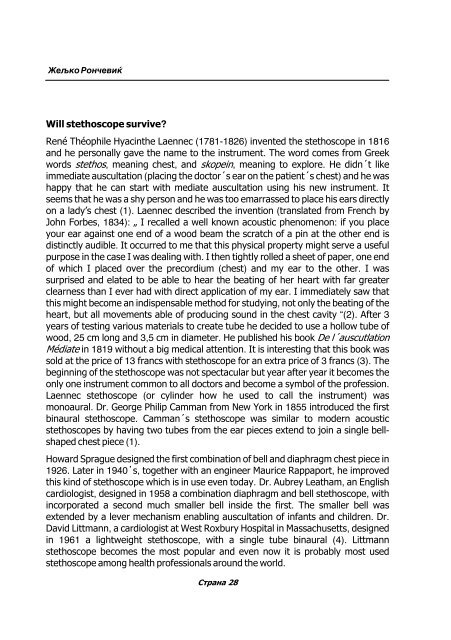Conduct disorder
Conduct disorder
Conduct disorder
You also want an ePaper? Increase the reach of your titles
YUMPU automatically turns print PDFs into web optimized ePapers that Google loves.
@eqko Ron~evi]<br />
Will stethoscope survive?<br />
René Théophile Hyacinthe Laennec (1781-1826) invented the stethoscope in 1816<br />
and he personally gave the name to the instrument. The word comes from Greek<br />
words stethos, meaning chest, and skopein, meaning to explore. He didn´t like<br />
immediate auscultation (placing the doctor´s ear on the patient´s chest) and he was<br />
happy that he can start with mediate auscultation using his new instrument. It<br />
seems that he was a shy person and he was too emarrassed to place his ears directly<br />
on a lady’s chest (1). Laennec described the invention (translated from French by<br />
John Forbes, 1834): „ I recalled a well known acoustic phenomenon: if you place<br />
your ear against one end of a wood beam the scratch of a pin at the other end is<br />
distinctly audible. It occurred to me that this physical property might serve a useful<br />
purpose in the case I was dealing with. I then tightly rolled a sheet of paper, one end<br />
of which I placed over the precordium (chest) and my ear to the other. I was<br />
surprised and elated to be able to hear the beating of her heart with far greater<br />
clearness than I ever had with direct application of my ear. I immediately saw that<br />
this might become an indispensable method for studying, not only the beating of the<br />
heart, but all movements able of producing sound in the chest cavity “(2). After 3<br />
years of testing various materials to create tube he decided to use a hollow tube of<br />
wood, 25 cm long and 3,5 cm in diameter. He published his book De l´auscutlation<br />
Médiate in 1819 without a big medical attention. It is interesting that this book was<br />
sold at the price of 13 francs with stethoscope for an extra price of 3 francs (3). The<br />
beginning of the stethoscope was not spectacular but year after year it becomes the<br />
only one instrument common to all doctors and become a symbol of the profession.<br />
Laennec stethoscope (or cylinder how he used to call the instrument) was<br />
monoaural. Dr. George Philip Camman from New York in 1855 introduced the first<br />
binaural stethoscope. Camman´s stethoscope was similar to modern acoustic<br />
stethoscopes by having two tubes from the ear pieces extend to join a single bellshaped<br />
chest piece (1).<br />
Howard Sprague designed the first combination of bell and diaphragm chest piece in<br />
1926. Later in 1940΄s, together with an engineer Maurice Rappaport, he improved<br />
this kind of stethoscope which is in use even today. Dr. Aubrey Leatham, an English<br />
cardiologist, designed in 1958 a combination diaphragm and bell stethoscope, with<br />
incorporated a second much smaller bell inside the first. The smaller bell was<br />
extended by a lever mechanism enabling auscultation of infants and children. Dr.<br />
David Littmann, a cardiologist at West Roxbury Hospital in Massachusetts, designed<br />
in 1961 a lightweight stethoscope, with a single tube binaural (4). Littmann<br />
stethoscope becomes the most popular and even now it is probably most used<br />
stethoscope among health professionals around the world.<br />
Страна 28


